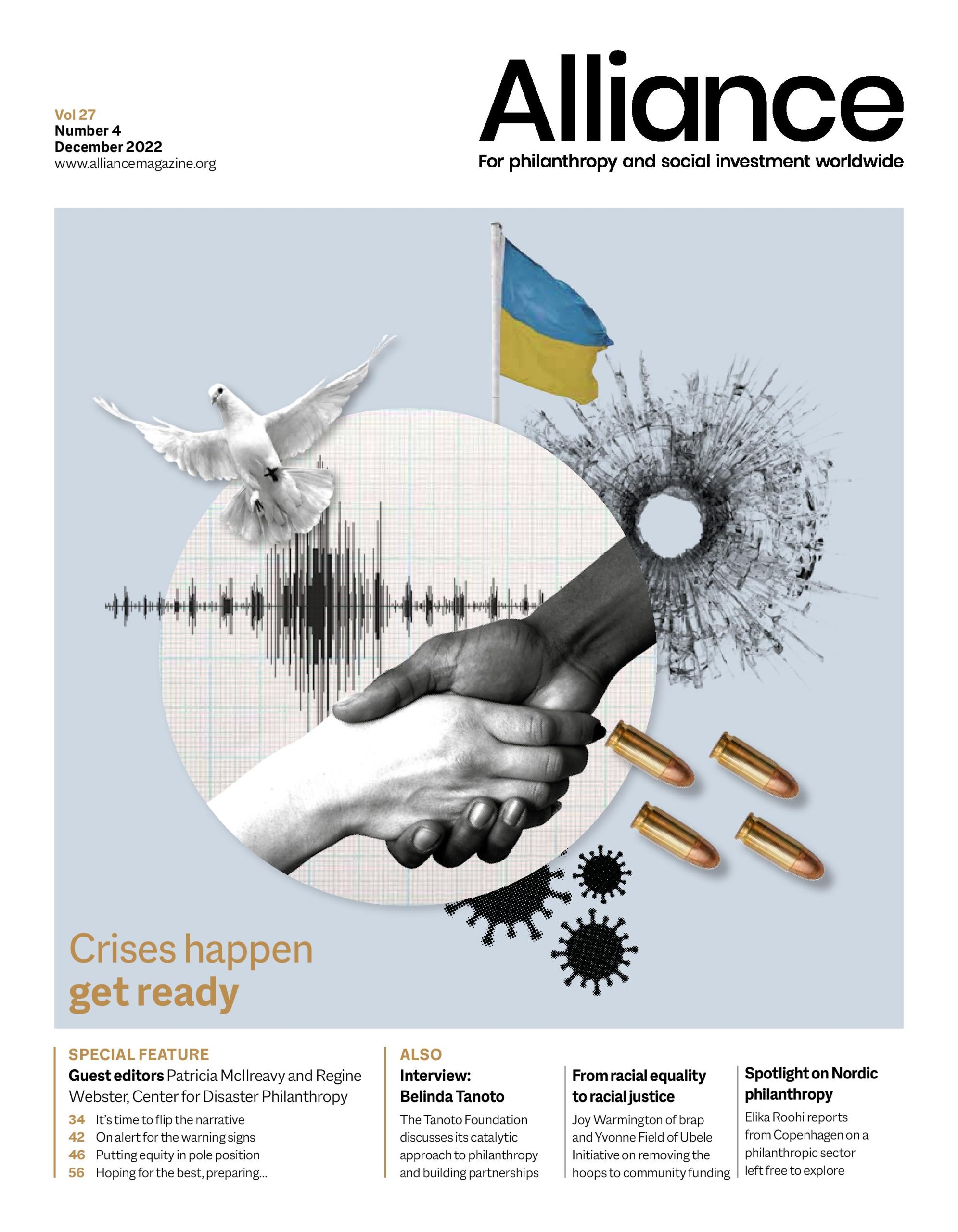Current narratives about how to practise philanthropy in the wake of crises are undermining both the effectiveness and the credibility of the sector in doing so. Time to flip those narratives
In his opening remarks at the 77th United Nations General Assembly in September, UN secretary-general António Guterres warned, ‘Our world is in peril and paralysed. Divides are growing deeper. Inequalities are growing wider.’ He added: ‘We have a duty to act. And yet we are gridlocked in colossal global dysfunction. The international community is not ready or willing to tackle the big dramatic challenges of our age. These crises threaten the very future of humanity and the fate of our planet.’
The scale and frequency of natural hazards is increasing; complex emergencies are forcing record numbers of people from their homes, and the Covid-19 pandemic exposed the severe risk that infectious diseases carry for all countries.
Sobering words indeed and words that resonate. We are living in a time unlike any other. Social disruptions occurring worldwide – growing economic disparities, protests calling for an end to inequities and the rise of popularism – are just a few of the concerns. In addition, the scale and frequency of natural hazards is increasing; complex emergencies are forcing record numbers of people from their homes, and the Covid-19 pandemic exposed the severe risk that infectious diseases carry for all countries.
We also know that climate change will result in additional economic, social and political pressures. For those whom society has already made vulnerable, inequities will be exacerbated.
While unprecedented times of overlapping crises, insufficient funds and increasing demands threaten to overwhelm us, it is also a time of opportunity. It is the time for those who seek to help those most affected by disasters to discard the barriers and silos we have built around ourselves. Time to celebrate tearing down systems of oppression rather than a community’s resilience to those systems. And time to practise the lessons we’ve been taught time and again, that centring affected people is critical to effective grantmaking.
Collaborate through common values
Decades ago, when I first started in the humanitarian sector, a friend who worked for the US Agency for International Development advised me to be cautious, that the path of humanitarianism was one of ‘instant gratification’ altruism. While cutting, it was an astute observation, for that simple phrase questioned the centring of self that occurs in the disaster relief and humanitarian spheres, a centring that is evidenced through mandate-driven assessments of affected population’s needs, the speed at which programmes are designed and even as an undercurrent for donors’ and non-profits’ marketing and branding.
While I may not have recognised it as such at the time, I quickly learned that within her advice was also the undercurrent of an insult often repeated. Be it conflict in Ukraine, floods in Pakistan, famine in Somalia or hurricanes in Florida, the world still looks to humanitarian and disaster professionals to be the first in, portraying these workers and their efforts as simplistically heroic, a perception fuelled not only by the media but, at times, by the non-profits doing the work themselves. While the sector has changed much since my first forays in humanitarian work, this narrative has not.
With all respect to my colleagues operating in some of the hardest imaginable conditions, I believe this perception dismisses the sector’s professionalism, elevating bravery over skill, dedication and experience. Additionally, it has allowed donors to continue prioritising response over recovery and for our peers working in development, peacebuilding and democracy to be dismissive of the role we all share in aiding communities on their path to sustainable development.
The world still looks to humanitarian and disaster professionals to be the first in, portraying these workers and their efforts as simplistically heroic, a perception fuelled not only by the media but, at times, by the non-profits doing the work themselves.
The universal values of the Sustainable Development Goals call on us to ‘leave no one behind’. We know that the average length of displacement from conflicts or disasters is 20 years. The Internal Displacement Monitoring Center estimates 55 million people are currently internally displaced, while the UN High Commissioner for Refugees estimates there are 27 million refugees worldwide. And yet, funding remains short term, with the power of decision-making resting predominantly in the hands of donors and operational agencies.
The structural hindrances and negative incentives baked into the various structures and systems set up to help in complex emergencies and other disasters are well-documented, as are the results of how competition between mandates, fundraising and egos limits accountability to affected people.
The current moment demands we change. We must centre communities and listen to the solutions they propose and, if this solution is not something we fund or do, we must be willing to aid them in finding the partner they require instead of forcing them to fit our programming priorities.
It will take courage to devolve power and resist the desire for self-attribution to encourage self-determination, foster open collaboration and advance collective advocacy. These changes are possibly an existential challenge to many of us and our current way of doing business, but better we change than humanity suffers.
Be our best
Years ago, in the throes of yet another humanitarian system reformation effort, I was challenged by a peer – how do we create a checklist that accommodates the message ‘work smarter’? We never found a collective solution to why the message alone was insufficient. In the end, the reform was less than successful as the bureaucratic checklists and matrices sent to country offices to dictate a behaviour change created more, not smarter, work.
This experience taught me that some inherently resist simplicity in messaging. And yet, to mean what we say and say what we mean is often what we require. Two examples of this are our narrative around resilient communities and sustainable programmes.
I struggle with the framing of resilience. Rather than resilient, should not our desire be for people to be self-empowered and have dignity and choice over their future? Does not celebrating their resilience amid systems that continue to disempower and beat them down risk dismissing the root cause, the structural inequities holding them back? Instead of seeking resilient communities, we should encourage thriving communities. We should support them in their journey to greater preparedness for, mitigation of, and recovery from crises. In this, we will join with communities in choosing hope over despair at what may come.
Rather than resilient, should not our desire be for people to be self-empowered and have dignity and choice over their future?
Sustainability is another double-edged term; on the one hand, it implies the ownership of the affected people or grantee partners of the future of the intervention. However, it also includes an expectation from the donor that a project or non-profit is static, unaltered by circumstance and future-focused. The search for the perfect project or partner that can promise sustainability excludes the many worthwhile interventions that may not have longevity but offer innovation or possibly even learning from failure. In stepping back from the search for sustainability, we may surprise ourselves with what we discover to be transformative.

McIlreavy talks to Rohingya children in the huge Cox’s Bazaar refugee camp in Bangladesh. Credit: Carolyn Aeby
Cede leadership space
The calls for localisation – in leadership, programme design and direct funding – are not new. Local is defined as increasing direct funding to local humanitarian actors, investing in the capacity of local actors and their access to coordination mechanisms, and creating space for local leadership. The evidence for the benefits of locally-led action is indisputable: local organisations have a greater understanding of context, culture and affected communities. They are thus better placed to understand their needs and develop innovative solutions. Despite promises made at the World Humanitarian Summit in 2016 and through the ongoing Grand Bargain process to increase funding to local actors and hold a ‘participation revolution’, many donors remain hesitant. Funds continue to go predominantly to international actors, especially in complex humanitarian emergencies and large-scale disasters.
Sometimes, the donor narrative around why (or why not) to fund local non-profits and community-based organisations undermines potential localisation successes. Donors will speak of the value of localisation as a way to save on costs – localisation is ‘cheaper’. This mindset is not a viable starting point for an equitable power-sharing relationship; donors should seek to accept the costs of programmes completed effectively, efficiently and capably, including an appropriate level of duty of care.
The evidence for the benefits of locally-led action is indisputable: local organisations have a greater understanding of context, culture and affected communities. They are thus better placed to understand their needs and develop innovative solutions.
Other narratives invoke capacity or increased risks when funding national or local actors versus the tried and true larger organisations. These arguments codify myths, as every organisation has had to build its capacities, maintain or develop organisational viability, and constantly mitigate risks.
We need to challenge our biases and alter internal structures and processes to allow us to follow through on promises made during the summit.
Address root causes
In his speech to UNGA, Secretary-General Guterres also spoke to the many crises and the underlying causes that threaten a prosperous collective future. The list was long and, for philanthropy, might seem more extensive than their interests or capacity. However, addressing the root causes is not a solo assignment.
The most direct path to addressing root causes within your programming is to listen to communities and explore what they propose within your mandate or abilities. It also requires clarity in understanding how your funding can make a difference, remembering that there are others you can call upon to assist with other needs. In a crisis, how we save lives is just as important as the act of saving them.
For example, in the Center for Disaster Philanthropy’s (CDP) planned funding for Ukraine, the team decided on a thematic approach versus a traditional sectoral one to invest in long-term equitable recovery. This investment will take the form of supporting and strengthening the representation and influence of marginalised groups – older people, LGBTQIA+, persons with disabilities, the Roma community, children and third-country nationals – in response and development agendas through access to improved skills, targeted evidence and coordinated advocacy, among others.
The CDP team can take this position with the confidence that other funders will support immediate relief needs, human rights, democracy or peacebuilding and the more significant infrastructural needs that will follow peace when it comes.
CDP’s funding for disasters such as the hurricanes that devastated the US east coast has the same goal – equitable recovery – though the programming will adapt and adjust to the contextual challenges faced by racialised and marginalised communities in the country. Our grantmaking will be attentive to the systemic inequities within the relief structures available to affected populations and demonstrate an openness to recovery needs, including mental health, disaster case management, legal services and shelter support.
In the Center for Disaster Philanthropy’s (CDP) planned funding for Ukraine, the team decided on a thematic approach versus a traditional sectoral one to invest in long-term equitable recovery.
The American novelist Alice Walker said it best: ‘We are the ones we have been waiting for.’ Let us set an example for others through bolder, deliberate actions and simpler narratives. Together we can model the change the world needs.
Patricia McIlreavy is president and CEO at the Center for Disaster Philanthropy.
Email: patricia.mcilreavy@disasterphilanthropy.org
Twitter: @McIlreavyP











Comments (0)